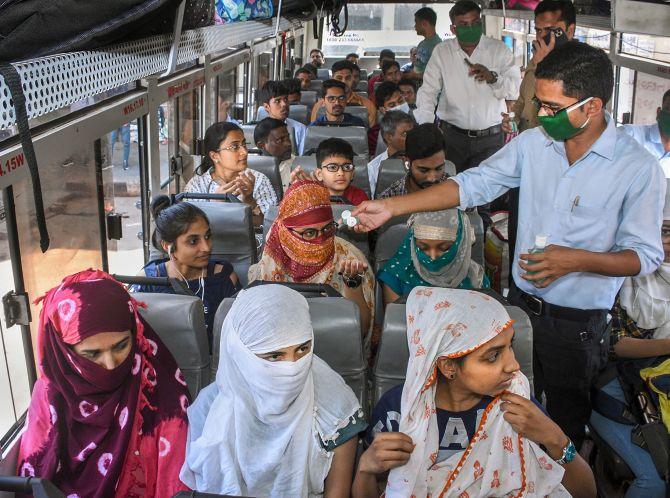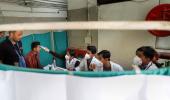When it comes to key medical infrastructure and health care investments, the country fares worse than the top affected nations, report Sachin P Mampatta and Sohini Das.

Government announcements shutting down malls and other crowded places might well be key to any chance of India managing the coronavirus outbreak.
An analysis of medical infrastructure and other data of the top 10 affected countries shows that India lags far behind on the resources required to deal with a pandemic.
The World Health Organization recorded 1,32,536 cases across 123 countries in the week ending March 13. China, Italy, Iran, South Korea, Spain, France, Germany, the United States of America, Switzerland
and Japan are the top 10 countries based on cases detected. They accounted for over 90 per cent of covid-19 patients.
India has fewer hospital beds and doctors per 1,000 people than any of those countries. A significant section of people might not even have adequate facilities for washing hands, a basic requirement to keep
the disease at bay.
India also has a high chance of people being pushed into poverty because of out-of-pocket healthcare expenditure, suggesting that a widespread pandemic may well have wealth and inequality consequences, too.
Many of the figures used for the analysis from the World Bank appear with a lag, but provide a broad picture of the gap between India and key affected countries. The analysis considered the year with the latest available data for India, and that year’s data for other countries was taken for comparison, where available, or the year closest to the India data.
India has 0.7 hospital beds and a similar number of physicians per 1,000 people in 2011. China had 3.8 for the same year and Italy had 3.5. China also had a higher number of physicians (1.8) as did Italy (4.1).
Hand washing is one of the recommended ways of avoiding covid-19. Data shows that 50.7 per cent of the rural population does not have basic hand-washing facilities, including soap and water (2017 data). It was 20.2 per cent in urban areas, around 40.5 per cent for the population overall.
Indians are also particularly vulnerable to being pushed into poverty by the expenses of catching a major disease. The proportion of the population pushed below the $1.9 poverty line because of out-of-pocket healthcare expenditure was around 0.03 per cent for Iran showed a 2011 study. It was 4.16 per cent in India.
This appears to be in line with the fact that India has not been a big spender on health. Comparative international figures are available for 2016 with the World Bank, which shows that India spent 3.14 per
cent of general government expenditure on health, compared to China’s 9.05 per cent, Italy’s 13.47 per cent and Iran’s 22.6 per cent.
India has since seen a widespread rollout of Ayushman Bharat in an attempt to have universal health coverage. However, this has also run into some headwinds, including reach and reports of hospitals
refusing patients under the scheme.
“Well I think when a pandemic like this hits any country most health care (infrastructure) will fall short. I think the government has acted very swiftly and has been proactive. This kind of mass hysteria
globally I have not seen before,” said Ranjan Pai, chairman of Manipal Education and Medical Group.
Global hysteria has been fuelled also by the absence of key requirements such as masks and respiratory equipment, an issue that India could also face, according to the manufacturing segment.
“The soft underbelly of India’s healthcare security stands exposed in (the) absence of imports from China for many devices where India was overly dependent… (domestic companies are) ramping up manufacturing capacity to take advantage of global shortages in masks and gloves, and other consumables,” said Rajiv Nath of Association of Indian Medical Device Industry, he is also the managing director of Hindustan Syringes and Medical Devices.
Nath said that they were working on compiling data of the manufacturing capacity and capabilities for ventilators and oxygen supplies.
The WHO said on March 3 that it had shipped half a million sets of protective equipment to 47 countries, but supplies are still falling short. It estimated that manufacturing must increase by 40 per cent to meet global demand. It has set up a fund called “The covid-19 Solidarity Response Fund”.
The fund has been organised with the help of the United Nations Foundation and the Swiss Philanthropy Foundation. It is seeking financing for protective equipment for medical workers on the frontlines, for
diagnostic laboratories, improving surveillance and data collection, and to “establish and maintain intensive care units; strengthen supply chains; accelerate research and development of vaccines and
therapeutics; and take other critical steps to scale up the public health response to the pandemic,” according to a note.
This comes even as developed countries too have been overwhelmed by the large numbers needing care simultaneously. Foreign news reports indicate that Italy is already been facing a shortage of ventilators and beds in the intensive care units of its hospitals. Medical professionals now may have to choose who to help and who, as one report put it, leave “gasping for air”.











